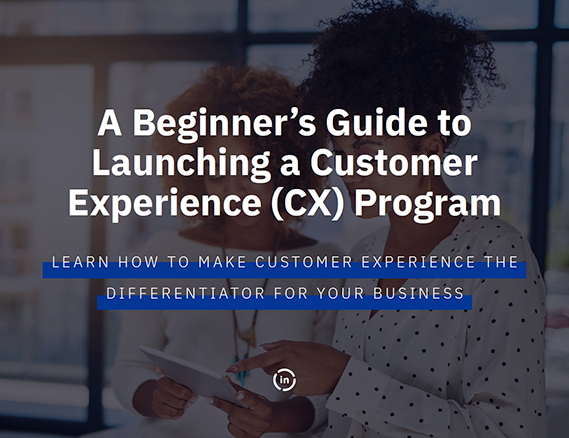Customer Experience Defined
Customer experience (CX) describes how customers feel about their collective experiences and interactions with a company—including their overall relationship with a specific brand. Customer experience programs refer to an organization’s ongoing efforts to listen to and collect customer feedback, measure customer perceptions of their experiences, and ultimately improve those experiences to encourage positive brand perception and business growth. Customer experience can also be referred to as customer experience management (CXM or CEM).
Why Does Customer Experience (CX) Matter?

Every successful business understands the importance of providing seamless, positive experiences. After all, 65 percent of customers want to buy from companies that offer quick and easy online transactions. That’s why many successful businesses employ CX programs to listen carefully to customers, understand what they need, and use that information to become more efficient and responsive. But as organizations grow and become more complex, these crucial personal customer connections become more difficult to manage. This is especially true in a world where people interact with modern businesses in thousands of different ways across many touchpoints.
What’s the Difference Between Customer Experience and Customer Service?
Although customer experience and customer service are often used as synonyms, and they do have some overlap, they’re actually two different things. Customer service is a single circumstance when the customer seeks support or resources, which is a part of customer experience. However, customer experience refers to the overall experience that a customer has had with a brand and how they perceive that brand.
Benefits of Providing a High-Quality Customer Experience
Improving the customer experience at your business will take time, effort, and money, but customer experience is worth the investment. When your customers are having a good experience, your business can:
- Boost Revenue: a good customer experience leads your customers to want to spend more money, which leads to more revenue. In fact, studies have shown that companies that earn one billion dollars annually can earn up to one billion dollars more within three years of investing in customer experience management.
- Increase Brand Awareness: a good customer experience makes your company memorable—in a good way. If your customer experience is consistent in this way, a good customer experience can become part of your brand.
- Improve Customer Loyalty: when a good customer experience is part of your brand, customer loyalty will follow. Studies have shown that 86% of those who have a good customer experience at a given company are more likely to make another purchase there. People will like knowing that they can expect a good experience when they come to you, so they’ll be more likely to continue to frequent your business.
- Improve Customer Acquisition: a good customer experience will also boost your rate of customer acquisition, since satisfied customers are much more likely to leave you good online reviews and recommend you to their families and friends.
To achieve these benefits, you’ll need deliberate CX management that will help you curate a customer experience from the beginning of the customer interaction to the end. You’ll also need to understand the difference between a good customer experience and a bad customer experience with your organization.
Examples of Good and Bad Customer Experience
A good customer experience is one where a customer leaves an interaction with a brand feeling pleased and satisfied overall with the service they received. Businesses don’t need to have a perfect experience with a customer for them to feel positive about their customer experience overall. Likewise, a bad customer experience is one where a customer has a disappointing experience with a company where they feel that their needs are not being met and their concerns are being ignored.
The two parts of the customer experience are the people and the products involved. A good customer experience involves attentive customer service representatives and products or services that perform well, while a bad customer experience is lacking in these respects. See some examples below.
Examples of Bad CX
Though there are degrees of how bad a customer experience can be, one example that many of us are familiar with is when a restaurant gets your order wrong. This in and of itself can be due to an innocent mistake, which doesn’t have to define the customer’s experience. But if a customer brings the mistake to the staff’s attention and the staff is indifferent, unkind, or makes no attempt to rectify the mistake, this becomes a bad customer experience.
Another example of a bad customer experience is when a customer is unable to reach a company for technical support. This could happen due to long wait times, poor automated phone prompts, or a lack of available contact channels. Here the problem is with a lack of accessibility rather than just a lack on the part of the customer service representatives.
In both scenarios, a lack of attentive customer service personnel and a lack of satisfying services can lead to customer dissatisfaction and negative reviews.
Examples of Good CX
On the other hand, an example of a good customer experience at a restaurant might also include a mistaken order. If a customer’s order is wrong and they bring it to the staff’s attention, they might still enjoy a good customer experience if the staff is attentive, apologetic, and takes appropriate action to make up for the error—perhaps by offering the customer a discount or adding a special item to their order for free.
A good technical support customer experience would be one in which the customer is able to easily access the right support personnel, who are then able to communicate clearly and help the customer solve their issue in a timely manner.
Being given access to attentive customer service representatives and being provided with the service or product that meets their needs leaves a customer feeling satisfied and more inclined to rate your business well.
You can also take your customer experience to the next level by providing service that exceeds customers’ expectations. The trick is to learn what customers expect from you and your services and determine what elements of your customer experience to improve upon.
Using a CX program in these scenarios is important so that when your customers leave feeling dissatisfied, you can seek out ways to help improve those situations rather than let negative experiences affect additional customers over time.
6 Important CX Elements for Any CX Strategy
#1: Personalization
Long story short, knowing who your customers are, and what makes them tick will be a huge benefit to you when focusing on their experience.
#2: Integrity
Your relationship with your customers is built on trust and dependability. Being honest and up-front in your communications helps your customers to rely faithfully on you and your brand.
#3: Expectations
Set realistic expectations for your customers. Try to be as transparent as possible when setting costs, wait times, and so forth. More importantly, make sure you know what expectations your customers have set for you. Nowadays, people expect companies to know exactly what they’re wanting from them and hope that those businesses can anticipate their needs. Try to uncover those expectations as early on as possible so you’re not being held to unrealized standards.
#4: Resolution
When problems arrive, it is up to the company to jump on that resolution in a timely manner. This prevents any negative feelings from festering. Oftentimes when an issue arises and is subsequently solved within 24 hours, customers will let those inconveniences go.
#5: Time & Effort
CX is often determined by how quickly and easily the customer can accomplish their goals with your business. When your business operates across multiple platforms, how seamless are the transitions? What can you do to make your site a one-stop shop for whatever your customers need? How long does it take your customer to get what they need?
#6: Empathy
The sixth and final pillar, but certainly one of the most important. It’s one thing to accomplish what your customers want, and it’s another to go above and beyond and show them that you understand their goals and desires. Make those personal connections with your customers and you’ll be sure to give them a positive customer experience.
Tips for Building a Smart, Successful CX Program
Most organizations have some kind of formal customer experience program in place. These programs work to align a company’s actions around a customer-centric strategy, spread customer intelligence throughout an organization, and to establish an appropriate governance structure. Here are a few tips businesses can follow to build great customer experience programs:
Unify the Business Focus
The most successful CX teams play a crucial role in unifying and aligning frontline employees, management, product teams, and executive leadership around customers’ core needs.
Build Customer Personas
Customer personas, also known as buyer personas, create clear portraits of potential customers, often literally putting a name — if not a face — to a hypothetical member of your abstract target market. This fictional representation can help your business better understand the specific needs and wants of their customer base, as well as the problems they face. When you understand these specifics, you can then tailor your customer experience to better meet your customers’ needs.
Build Customer Journey Maps
Customer journey maps provide a visual representation of a customer’s experience with your company, from pre-purchase to post-purchase. By understanding this journey, your CX teams can identify pain points as well as solutions and opportunities to improve the customer experience. Customer journey maps can provide insight into the buying process, customer actions and emotions, and where your company might fall short of meeting expectations. A customer journey map can help your team anticipate and remove predictable issues from your customer’s journey, which enables customers to more easily achieve their goals and ensures a better customer experience.
Understand the Current CX Challenges
If your CX team is already aware of challenges in your current customer experience, do the necessary research to explore these issues. Data from customer feedback and use case studies can be especially helpful in identifying and analyzing areas where your customer experience needs to be improved.
Communicate
Your customer experience is likely built by several different teams, from product development to customer support. As you seek to improve customer experience, make sure that these teams communicate with each other to optimize the customer journey. Ensure that everyone is on the same page with regular updates and meetings that encourage collaboration and sharing of information.
Use Technology
Technology also plays a crucial role in these CX efforts by enabling companies to gather feedback from many different touchpoints, analyze it, and distribute it to the people responsible for making positive changes in specific areas. With an effective Experience Improvement (XI) Platform, businesses can identify customer issues and trends earlier, respond quicker, and turn everyday customer experiences into key competitive advantages.

GUIDE
A Beginner’s Guide to Launching a Customer Experience (CX) Program
A guide written for any business leader wishing to learn about CX programs, launching a CX program, how to become better at delivering and improving CX, getting closer to customers, or getting better information that will lead to more revenue and smarter decisions.
How to Measure Customer Experience?
There are a variety of ways to measure CX. If you need metrics to measure CX, you can use the following, which are the most popular CX metrics:
Net Promoter Score (NPS):
NPS, or Net Promoter Score, is one of the most popular metrics for measuring CX. This method focuses on a question in the style of “On a scale from 0-10, how likely are you to __?”. These results are then used to find promoters, detractors, and neutral results that all measure out to calculate the overall positive or negative score.
Customer Satisfaction Score:
You’ve probably seen this metric used to measure your experience at a restaurant, when your waiter leaves you a brief survey asking about your experience on a scale from 1-5 (1 being poor and 5 being excellent).
Customer Churn Rate:
This measurement tool mainly assesses how often you’re getting repeat customers. You can gather this information by monitoring how many monthly subscriptions you lose/gain, or analyzing your monthly recurring revenue. There are a lot of factors that can influence your churn rate, from internet trends to business location.
Analyze Customer Support Ticket Trends
Sales reps resolve a series of support tickets every day, these provide a great data point which should be analyzed. If businesses notice recurring issues among tickets, they should review potential reasons for these issues and come up with solutions to reduce or eradicate the problems across the board. This should decrease the total number of tickets reps receive while improving customer experience.
How to Improve the Customer Experience
Having a successful CX strategy is important, but strategy will do you no good without action. In order to improve customer experience, your business must gather important customer insights and then use them to make tangible improvements in the following ways.
Determine what Customers Value Most and Deliver
As you seek to improve your customer experience, gather information on what your current customers value most. You can leverage customer feedback surveys and analyze customer reviews, both good and bad, to determine what your customers are looking for from your company.
Do your customers want your services to be more convenient? Do they want to know more about the service before they buy or subscribe? Do they have concerns about how their information is used and protected? Do they want to spend less time on the phone with customer service representatives?
As you discover what it is that your customers are looking for, take steps to deliver it to them.
Let Customers Know Their Opinions Matter
Tell your customers that you’re listening and making changes to improve their experience. Advertise the changes you are making on your website or through social media. You may also want to thank customers for providing feedback and be quick to address any concerns that they express by reaching out to them personally.
Measure Improvements
As you proceed with your CX improvement strategy, measure the response from your customers with relevant metrics. As you keep track of things like conversions, customer complaints, purchases, and website traffic, you’ll be able to figure out which of your efforts are paying off and which are not.
Consider the Digital Experience
Be sure to pay attention to the digital aspect of your services. Making improvements to aspects of the customer experience like your website navigation or automated phone menu options can vastly improve how easily and readily your customers can avail themselves of your services. Convenience and accessibility are large parts of a good customer experience, so be sure not to neglect how technology can help in your overall CX strategy.
Aim for Continuous Improvement
Even as your improvements take effect, build upon your successes by continuing to analyze and improve your customer experience. Don’t rest on your laurels — in today’s constantly changing world of digital commerce, continuous improvement is needed.
This is especially true if your customer’s needs start to outpace your current customer experience model — for instance, you might need greater technology capacity to serve larger numbers of customers, or you might break into a niche market that has different needs.
How Can InMoment Help Improve Customer Experience?
InMoment offers businesses the unique combination of data, technology, and expertise they need to build best practice-driven CX programs. These include:
- Experienced CX strategists who are standing by to help define key CX objectives and design programs that deliver tangible results.
- Comprehensive data collection tools that make it possible to gather more data from more customer touchpoints and channels.
- A flexible, powerful technology platform that brings data from all these different sources together and turns it into both actionable intelligence and business changing insights via industry leading analytics.
- Case management tools that allow businesses to see and respond to customer issues instantly, close the feedback loop, and ensure important insights never get lost in the shuffle.
- Targeted tools, reports, and information that empower every member of an organization to improve products, processes, and policies.
- Best-in-class thought leadership and best practices resources that keep you up to date with the latest trends and hot topics.
It’s clear that CX programs are key to business success. You can take your CX efforts to the next level with InMoment’s revolutionary Experience Improvement approach, that helps you build a CX strategy that aligns the needs of your customers and employees with the needs of your business. Our proven approach helps you to acquire new customers, retain existing customers, identify cross-sell and upsell opportunities, and to cut costs by eliminating inefficient processes.
It’s time to stop managing customer experiences and start improving them! Learn what InMoment and our Experience Improvement approach can do for your business today!



